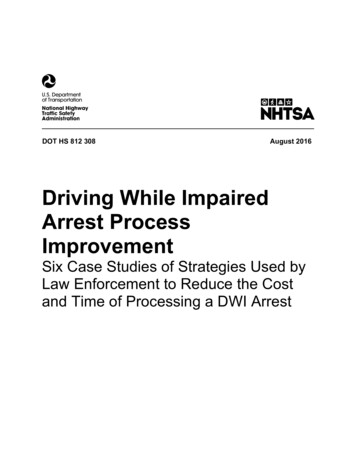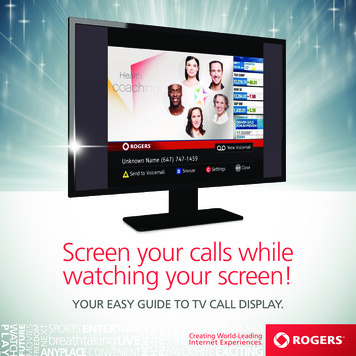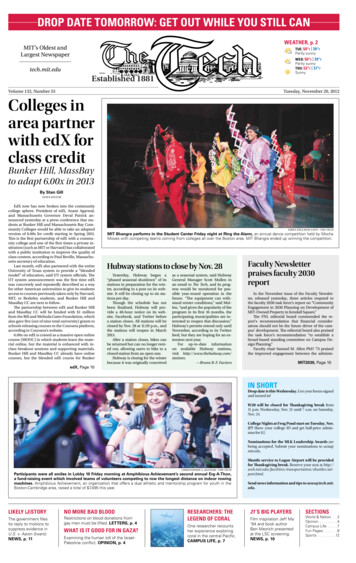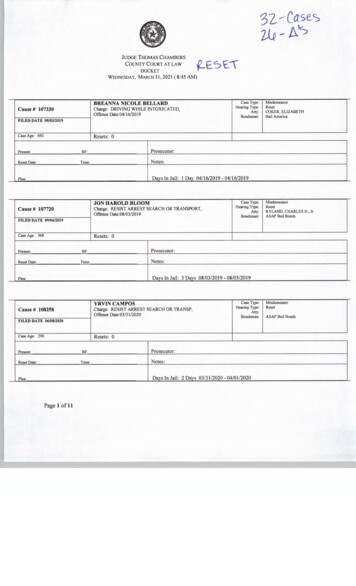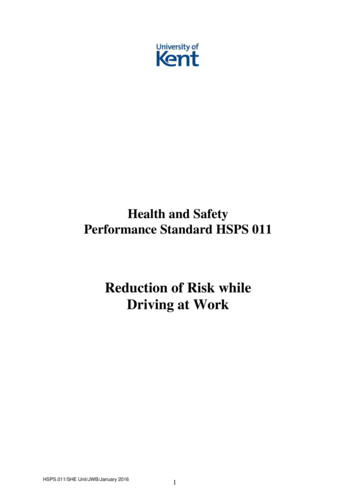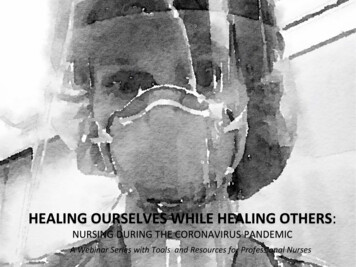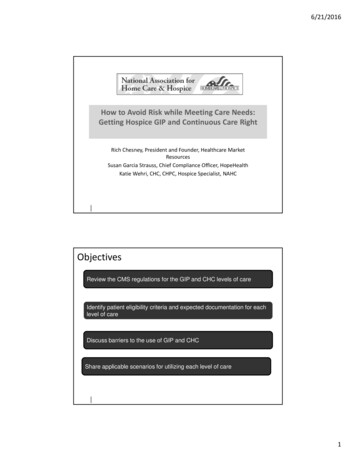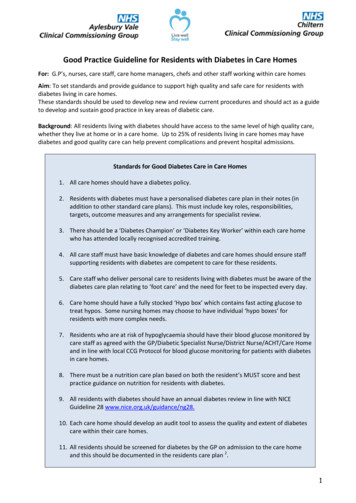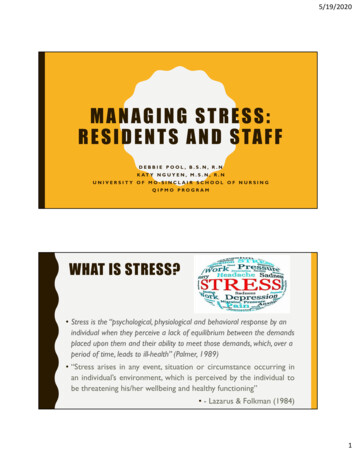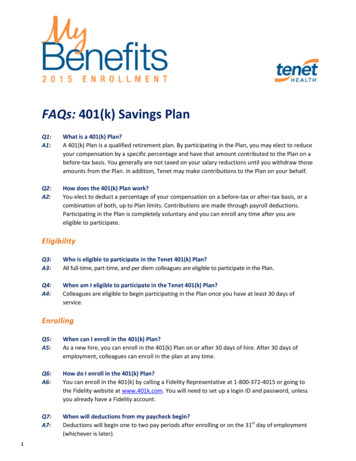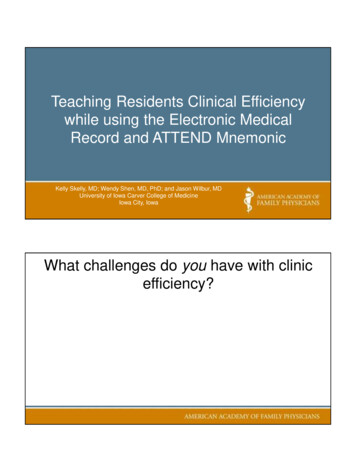
Transcription
Teaching Residents Clinical Efficiencywhile using the Electronic MedicalRecord and ATTEND MnemonicKelly Skelly, MD; Wendy Shen, MD, PhD; and Jason Wilbur, MDUniversity of Iowa Carver College of MedicineIowa City, IowaWhat challenges do you have with clinicefficiency?
Background All residents must learn comprehensive patientcare delivery Electronic Medical Record is part of care Previous surveys -90% residents and facultyrecognize need for efficiency training No studies look at training in EHR combinedwith efficiency and communication trainingObjectives for today Understand the need for teaching efficiency in theEMR while focusing on communications skillsneeded for best patient encounters Utilize one scripted approach to the EMR with theATTEND method and provenefficiency/communication strategies Provide a process to improve provider satisfactionafter participating in these workshops with datashared from our experience.
Methods 5 part workshop utilizing the EMR (EPIC) visitrequirements while addressing– simplified Essential Elements in Clinical Practice(Makoul)– ATTEND approach to EMR (Rosenbaum)– Team STEPPS key elementsSimplified Essential Elements in ClinicalPractice (Makoul) Pre-clinical preparation Rapport Building Encounter initiation Agenda setting Visit closure
ATTEND mnemonic for better patient-physician communication using the EMR 1.2.3.4. 1.2.3. here) 1.2.3.AAcquaint yourself with themedical recordTTake a minuteTTriangular placement ofcomputer, patient, clinicianEEngage, Explain, EducateNNo more screenDDescribe the dischargeDon’t forget to log-outAcquaint yourself with patient’s chart beforeentering the room, allowing for less chart review“screen time” while in the patient’s presence.Start the visit technology-free, giving the patientand his/her concerns your full attention.Triangular placement of computer, patient andclinician is most effective for allowing you to lookat both the screen and the patient, and the patient tolook at the screen and you.Engage the patient in your use of the computer as atool during the visit by using additional E’s: Explain to the patient what you are doing inboth entering data and also looking forinformation on the computer (sign-posting). Educate the patient by letting them see onthe screen what you are seeing, especiallygraphs, images, etc.When discussing sensitive information, completelydisengage from the computer (look at the patient,turn away from screen, take hands off keys, etc).Be explicit about what orders, etc, you are enteringin the computer at the end of the visit and what thepatient should expect (scheduling, tests, AVS, etc).Epic(EMR), ATTEND,Team STEPPSEpic will be yellow, ATTEND Purple, Team STEPPS greenEPIC SetupWidescreen (can select under more activities, can order under menu personalization)a.Encounter summary-choose buttons- include immunization certificate, ob, upcomingappointmentsb.Reviewc.Review flow sheetd.Result reviewe.Immunizationsf.Growth chartg.Roomingh.Clinic note- review how to float notei.Notej.Plank.Health maintenancel.Wrapupm.Chargesn.Procedureo.Initial prenatal visitp.Return prenatal visitq.LetterCreate templates/edit templatesa.AVS template must include @DIAGNOSISWITHCOMMENTS@, how followupresults will be communicatedb.Clinic visit template must include @DIAGNOSISWITHCOMMENTS@Diagnosis- expand buttonsMed/orders needs split view and correct buttons checked to allow refills correct.Pre-clinic Preparation AOpen note/start template (use new template or in create notes, use blue arrow button and copyHPI)—review how to float noteEnter known preventive data into note if relevant.Dashboard (TEAMSTEPPS)- update needs like PHQ or Pap or undress pt------end of first workshopRapport BuildingTake a minuteTriangular Placement (use rest of visit- especially closure)EngageRooming- update past/social/surgical histories (Can look at patient entered materialEncounter InitiationReopen Note, click edit- float or side bar- sentence or list- Patient lists concernsAnything else, anything else Screen not dive 1.2.3.4. 1.2.3.4.5. Agenda setting NClean problem listProblem list bring over to diagnosesDiagnoses- Add new items addressing with star primary diagnosisMeds and orders:a.Renewals (check pharmacy- if wrong, feedback/educate your team MA)b.New medsc.Other ordersd.Followup order- tell time of visit, date if known, overbook? Use ScheduleStaff here or after closure----end of workshopClosure NDComments (under diagnosis)- write the plan for each diagnosis (this could be anytime invisit)Write when f/u is planned.Share link for mychart via email if indicated.Print AVS and educate the patient. Consider highlightingUpdate Dashboard. Team STEPPSStaff here if didn’t after agenda set. Change diagnosis if needed.Note completion/chargeOnly need to finish HPI, add differential diagnosis, put in charge.---end of workshopConsider another workshop on how to do followup results
Write down your EMR name Take a moment and write the actual steps youuse in your EMR each time you see a patient.– Eg. What you do previsit What you do in the patient room in history taking with thecomputer, what you do in PE, what you do for your note,for assessment and plan, for your patient instructions
Five Workshops Dec-March Invitation emailWorkshopSummary email immediatelyFollowup email with key points reminder oneweek prior to next workshopWorkshop 1 Discuss challengesBasic background research (very brief)- Makoul,Bring up EMR patientOptimize EMR navigatorsDemonstrate what/where to do pre-clinic preparation First one was least immediately effective, but each builton the last and all were very interactive
Initiating the setting-topictrackingPre-clinic PreparationEstablishing initial rapportOpen the discussion and screen informationPatient’s opening statementBackground informationScreeningShare decision-makingExploring the patient’s perspectiveCo-creating a plan and shared decision-makingClosureFull summarization of issuesForward planningUtilizing Snapshot and EpicPlayground ttentive-Involvingthe patient
Workshop 1 Summary Let’s see how it works--– Epic (Your EMR) patient overview– Pre-clinic Preparation open note/start template– Enter known preventive data– Dashboard (eg. Pap, PHQ, undress)Poll Question: During clinic which slowsyour residents most Poor agenda setting No attention to after visit planning Resident can’t spend enough time with patientbecause of clerical computer orderrequirements Preclinic preparation By the way patients
Next Four Workshops Review the previous workshop Discuss interim challenges and successes Work on the next agenda real time- with “realpatients” in EPIC Give assignment– eg. Use dashboard, Open note before starting visit,Try agenda setting, Try ATTEND-triangulate, Use thenew note templateWorkshop 2- Preclinic Prep andcommunication How do you prepare for clinic– Chart review Interval history Your last note Prob list review and update– Labs first, whenever practical– Prescriptions needed? MA’s helping to identify refill needs.– Patient-provided data (questionnaires, emails, MyChart, Welcome)– Preparation starts at the end of the previous visit– Huddle with MA early in the session
Use the dashboard to communicateanticipated needs.Let’s take a field trip to Epic and look at:- using widescreen mode- opening a note- floating the note- filling in and updating basic info (Prob Listand prevention)
let’s talk about the “patient-physiciancomputer” relationship!*Why? Patient satisfactionAdherence to recommendationsTrust/information sharingPatient recall of informationInfluence health outcomesEfficiency?
*How do we establish rapport? ALWAYS start by addressing the patient directly – old, young, blind,deaf, non-English-speaking - it doesn’t matter Introduce yourself (first name, last name), smile, (shake hand) Talk about the weather, “where are you from?” Informal conversation Take social hx first Eye contact Open posture, sit forward Tie in nurses’ comments about reason for visitRole play Introducing EMR Introduction, 30-60 seconds rapport Turn the computer and say, “Let me bring yourrecord up on the computer, I’ll be using it as wetalk, you can see what I’m doing.”
Summary Workshop 2Pre-clinic and Communication issues- using widescreen mode- opening a note- filling in and updating basic info (Prob Listand prevention-ATTEND-RapportPOLL Question:How does agenda setting work in yourclinic and where does it involve the EMR?– The nurse does it on paper– The nurse types a list in EMR– The physician sometimes does it on paper– The physician types a list into every note– No-one does it– It is done but not in EMR
Workshop 3- Agenda Setting Background informationHow to do itHow to do it in EMRRole play*How will gathering information at thebeginning help? Avoid “By the Way ” phenomena: complete problem listselicited from patients decrease the likelihood the patient willintroduce new concerns at the close. (White, Levinson,etal,1994) Increases patient motivation: full lists allow shared decisionmaking and tailor the treatment plan to the full patientneeds.(Eisenthal, ‘79; Kaplan ’89; Williams 2000) Patient involvement from the beginning with determination ofproblem focus is essential to quality healthcare (henbest’90;Kroenke’98; Simpson ’91; Stewart ‘99)
*What Are We Actually Doing? Many physicians interrupt in 18-23 seconds to redirectthe interview (though if they gave only 6 seconds more,the patients usually complete the list), and 75% ofpatients never get to complete the list (Beckman ‘84;Marvel’ 99) 50% interrupt after 1 concern and 25% interrupt beforeany concerns are expressed (Braddock ‘99) Between 30-80% of patient expectations are notaddressed or identified (Kravitz ‘96; Marple ’98’ Schor’95)*Why? Fear loss of control of time (Dugdale ‘99) MDs feel compelled to address all of the patientneeds the same day (Berg ‘96; Hornberger ‘97) MDs are drawn the problems they can diagnose ortreat (keeps comfort and control). (Byrne ’76) Health maintenance lists get imposed on patientconcerns (Bass ‘86; Stewart ’79)
*Action Plan: Establish Focus This method increases the patient satisfaction andphysician satisfaction. This method doesn’t increase overall time spent Could increase compliance, overall patient feeling ofcontrol It should decrease time spent in future visits Allow you to maintain non- anxious relationship centeredpresence in face of complex or lengthy problem lists Agree on priority listingHow to do it?1. Skill- make a list- IN HPI. Never accept first answer, ask“something (anything) else?” until patient indicates completiontip: remind yourself you don’t need to address all theseproblems in one visit2. Skill: place relationship over need to focus- some patientsneed to tell the whole story before organizing. So listen andtrack concerns.3. Skill: avoid premature diving- postpone diagnostic interviewsequence and redirect the patient form in depth stories until allproblems are listed.
How to do it (continued)4. Skill- ask the patient to prioritize the listtip: ask yourself if you can address all thelist, if not, suggest followup even now.5. Skill- express concerns about issues whenrank order is different from patients. Negotiatewithout undermining patient autonomy6. Skill: seek confirmation and commitment.Helpful Phrases- hand out “Before we address any of your problems today, I wouldlike to hear a list of all your concerns.” (returnees,“what’s on your list today?” “Excuse me, but before we talk further about yourheadache, I’d like to know if you have other concerns sowe make sure to use our time in the best possible way.” “The first problem on your list is complex and to do agood job may mean not giving the same attention toother issues today and make another appointment soonto address them.”
Role play/Lets try it Remember–––––––Make list – “anything else? Something else?”Keep rapportDon’t prematurely dive/ don’t allow long storiesAsk pt to prioritizeDecide if you can address allNegotiate orderConfirm/commit to listInterim Plan and Next Encounter Try (during one whole clinic)opening clinic note template forevery patient prior to a visit. (WS1/2) Update dashboard once prior to visit with MA instructions.(WS1) Try doing the “anything else” during one whole clinic. (WS3) Try typing a list in the HPI real-time for at least 4 patients.(WS3)– With this and whenever working on Epic in the room with thepatient, try engaging the patient in what you’re doing. (ATTEND)
Workshop 4- Visit Closure Press-Ganey- Patient knows what to donext? Time spent planning*How are things going? Widescreen viewUpdate problem listAdd diagnosisStart the noteSet the agenda- list concerns, anything else?
Take a moment- on your paper What is your current closure in clinic? Whenyou do your assessment and plan how does ptleave? Make a list for patient Print prescriptions Get nurse to do labs and schedule How could you put it in EMR? 1.2.3.4.5. Closure NDComments (under diagnosis)- write the plan for each diagnosis (this could be anytime in visit)Write when f/u is planned.Share link for mychart via email if indicated.Print AVS and educate the patient. Consider highlightingUpdate Dashboard. Team STEPPSStaff here if didn’t after agenda set. Change diagnosis if needed.Note completion/chargeOnly need to finish HPI, add differential diagnosis, put in charge.---end of workshop
A/P- Diagnosis plus comments Our EMRAVS- another game changer
Follow up ordersSummary WS4: Interim Plan and NextEncounterEVERY TIME- clean problem list and medsEVERY TIME- keep rapport- Take a minute, triangulatecomputer and involve the patient with signpostMost times- try to agenda set- anything else?Before next visit- try the new template clinic visit and avsto have diagnosis plus comments- finish your clinic withevery impression and plan almost completely done!
POLL QUESTION: On which of the following do youspend most time? CookingSocial mediaSleepingElectronic medical recordsCMEexerciseFinal Workshop-tying it all together Review how it’s going- share tips Share survey results
Resident Survey Results 19/28 18 completed the survey who attended at leastone workshop (21 different actually attended) 84% feltthey were helpfulHow many residents attended all the workshops?0385512345Residents listed things they felt helpful Agenda setting- 50%Problem list updating 43%Using wide screen 25%Early note startingOthers: appreciated mychart signup, dashboarduse, typing in avs, typing in room
Incidental findings- faculty survey 13 faculty attended and 100% felt it was helpful Tips- Mostly EPIC specific 14/16 felt they would be interested in attendingfurther workshopsPre vs. Post training ResultsTime to note completion October (5.15 days), November (3.67-68 visits),December (4.15), Average- 4.42 days January (4.46), February (3.7), March (3.8) Average3.97 days Remember workshops started December but wentthrough early March. Best will be results for a year fromnow? Maybe numbers more based on time doing choresin EPIC?
Challenges Optimal objective data Lack of workshop attendance Level of learner could definitely impact time tonote completion Duration of data collection (over next year)Suggestions for Further Study Compare note completion time between providersattended workshop vs those did not. Evaluate data based on time of the academic year- a fullyear Utilize Epic flash functionality for time spent on parts ofEMR and time in room Overall Provider and Patient satisfaction Quality of note/After Visit communication Look at ATTEND and whether providers actually use it
Satisfaction Comments: Both Residents and Faculty made manycomments suggesting they felt these workshops were helpfulfor many intangible reasons. Mutual support? Teamwork? Allof this isn’t measured successfully in our study Communication studies suggest Shared Decision Makingbenefits patients with full and appropriate negotiation of planhelpful. If the Efficient Epic training works, it would likely leadto increased patient satisfaction as well 84% residents and 84% faculty would be interested inattendingPoll Question:Enter your email address to be included in any follow-upcommunication from the presenter(s).54
55Please Complete thesession evaluation.Thank you.56
References Essential elements of communication in medicalencounters: the Kalamazoo consensus statement.Makaul G. Acad Med. 2001 Apr;76(4):390-3. Rosenbaum M, Wilbur J, Skelly K, Jansen K. University of IowaCarver College of Medicine, 2014. Inspired by imPACT toolkitAlkureishi (Co-Primary), M,Lee (Co-Primary) W, Farnan J, AroraV. Breaking Away from the iPatient to Care for the Real Patient:Implementing a Patient-Centered EMR Use Curriculum.MedEdPORTAL Publications; 2014. ulumtools/teamstepps/index.htmlQuestions? Contact -Wilbur@uiowa.edu
Electronic Medical Record is part of care . 5 part workshop utilizing the EMR (EPIC) visit . Create templates/edit templates a. A
